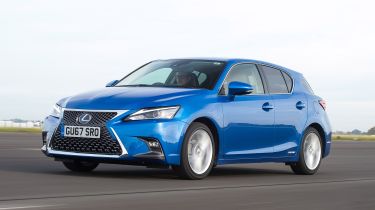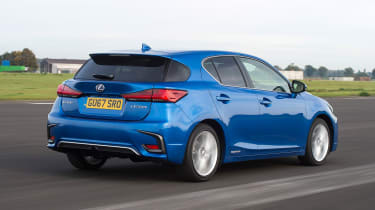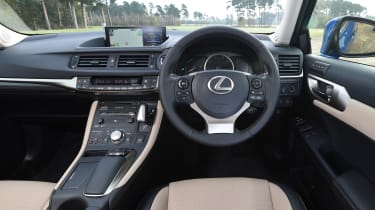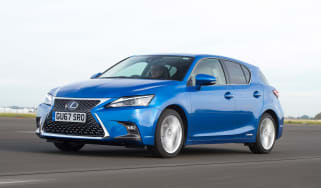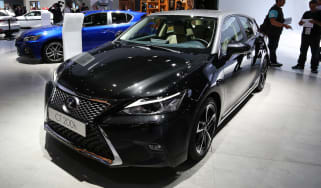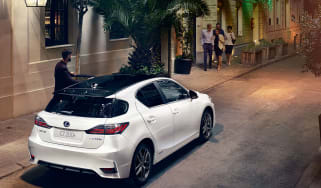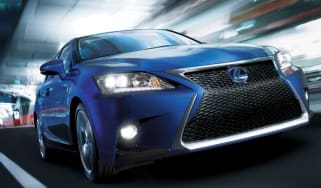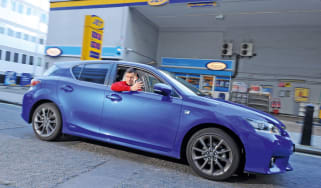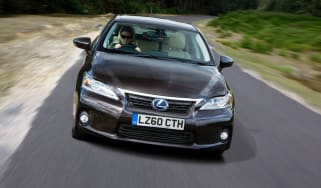Lexus CT review
The Lexus CT 200h has low running costs and a premium badge, but it's let down by a firm ride

The Lexus CT hybrid has always lived in the shadow of more talented and traditionally powered rivals even after a facelift in 2017. The updates (which according to the Japanese brand, included 94 improvements) tried to make the driving experience more exciting while maintaining the strong efficiency that many motorists found appealing.
Overall, the revisions resulted in more responsive handling, sharpened up the styling and improved comfort. Regardless of age, the CT is designed to take the fight to the BMW 1 Series and Audi A3, whilst also giving Toyota customers something to consider when looking to trade up.
With low emissions, Lexus has typically had company car buyers firmly in its sights, but it doesn’t deliver the sporty driver experience and upmarket style we were hoping for. All cars get the same 1.8-litre petrol engine, hybrid-electric motor and CVT gearbox.
Towards the end of 2020, Lexus announced that the end was nigh for CT sales in the UK. Despite this, the Japanese manufacturer continues to allow potential buyers to configure a new CT on its website, albeit in a reduced number of trims, and it is yet to confirm if or when a CT replacement is due.
Engines, performance and drive
Despite Lexus’ best attempts, the CT isn’t as engaging to drive as its rivals. The Japanese brand developed new laser-welding and body-adhesion techniques to give its car greater rigidity, but it still lacks the responsiveness of rivals.
More reviews
There’s also plenty of roll in tight corners, the skinny tyres surrender their grip sooner and the electrically assisted steering is light and lacks feedback. Selecting Sport mode turns the dials red, transforms the charge indicator into a rev counter and sharpens the throttle response, but it’s not enough to alter the underwhelming driving experience.
While the ride of the latest CT has been softened, it still feels uncomfortable and stiff as it crashes into potholes and fidgets over motorway expansion joints. On the plus side, the hybrid synergy system allows for quiet low-speed cruising and, surprisingly, the CT’s a sprightly performer.
However, the CT 200h’s strong performance is undermined by the CVT gearbox, which causes the engine revs to soar to a thrashy red line every time you accelerate hard, shattering the calm of the otherwise peaceful cabin. It also makes the car feel less responsive than its rivals when overtaking or powering up a steep hill. And as with other hybrid models, the Lexus suffers from a sharp brake pedal action, making it tricky to slow the car smoothly.
MPG, CO2 and Running Costs
This is where the Lexus CT 200h traditionally began to make sense – especially considering the CT’s powertrain is largely shared with Toyota’s previous-generation hybrid Prius. That said, the introduction of WLTP testing for official fuel economy and emission figures has somewhat ruined this.
For example, prior to WLTP entry-level S trim was quoted to emit just 82g/km of CO2. This would be enough to put it into the seventh-lowest company car tax band for petrol-powered cars and the fourth-lowest band for the tax due when a car is registered. Now, though, entry-level models (which are simply called ‘CT’) are claimed to produce 118g/km of CO2.
The result is the CT sits seven company car tax bands and three registration tax bands higher than it did before. The only other trim currently available, F Sport, is claimed to emit 119g/km of CO2. It is a similar story with fuel economy. Previously the CT was quoted to be capable of an impressive 78.5mpg, but is now between 53.2 and 55.3 mpg depending on specification.
Insurance
Insurance costs shouldn't be too high, as the CT occupies group 17 in both entry-level and F Sport forms.
Depreciation
Lexus models traditionally perform well as slow depreciators, although values for the aging CT have softened a little. After a typical three-year/36,000-mile period of ownership, owners should see a return of between 40-44% of their car's original list price.
Interior, design and technology
As part of the 2017 updates, Lexus attempted to give the CT 200h a sleeker and sportier look. The more aggressive ‘spindle’ grille already seen on the GS and IS appeared and the bumpers were also tweaked. F Sport models come with even racier styling courtesy of a shark-fin antenna, dynamic-looking rear spoiler and darker 17-inch alloys. Older entry-level S versions are quite some way off this level of aggression, as they came with seemingly tiny 15-inch wheels covered in aerodynamic trims. As a note, Lexus removed S models from the lineup in 2017 – meaning SE spec became the new entry point to the range until it too was dropped.
The interior is where things get better for the Japanese hatchback, as it lives up to Lexus’ reputation for both luxury and superb build quality. However, an overcomplicated design and cluttered centre console let it down. Three screens, as well as more than 20 buttons and switches, contrast starkly with the simple and practical layout found in cars such as the Volkswagen Golf.
Still, the standard kit list is decent and includes Bluetooth, automatic wipers, 17-inch alloy wheels and Lexus’ Safety System+. The latter consists of adaptive cruise control, a collision-avoidance system, lane keep assist and automatic high beams lights. It is worth noting that since the CT’s launch in 2011, there has been more than one refresh of the trims and their respective equipment. As such, if an older model is of interest it is worth taking a read of our used Lexus CT review.
Practicality, comfort and boot space
The CT’s 375-litre boot is decent, but folding the bench liberates just 985 litres, which is 235 litres less than in the Mercedes A-Class. Still, the boot floor is flush with the lip, making for relatively easy loading.
The location of the hybrid batteries under the rear chairs results in a high-set seating position, which affects tall occupants’ headroom. The news is better up front, with plenty of space and very comfortable seats. There’s also good storage, including an air-conditioned glovebox, various cup-holders and a handy, lidded centre console cubby.
Reliability and Safety
Lexus is renowned for reliability, and in 2020 the CT came 4th for reliability in the Driver Power customer satisfaction survey. Overall, Lexus’ hatchback ranked 19th (out of 75) for best cars to own. Quite impressive considering the CT is up against some considerably newer rivals.
The CT boasts eight airbags and electronic stability control as standard, plus it achieved a five-star Euro NCAP rating. Crash testers praised the car’s ability to protect its occupants, although it didn’t do so well in terms of pedestrian safety, scoring only 55 per cent.
Warranty
As with all Lexus models, the five-door carries a standard three-year warranty, while the hybrid system is covered by a five-year guarantee.
Servicing
A 10,000-mile intermediate service costs £225, rising to £570 for the 100,000-mile 'Full 100' major service. An annual 'Hybrid Health check' is also included when you have your car serviced at a Lexus service centre. With each hybrid-system health check you receive an extra 1 year or 10,000 mile (whichever comes sooner) hybrid battery warranty extension, until your vehicle is 15 years old.
